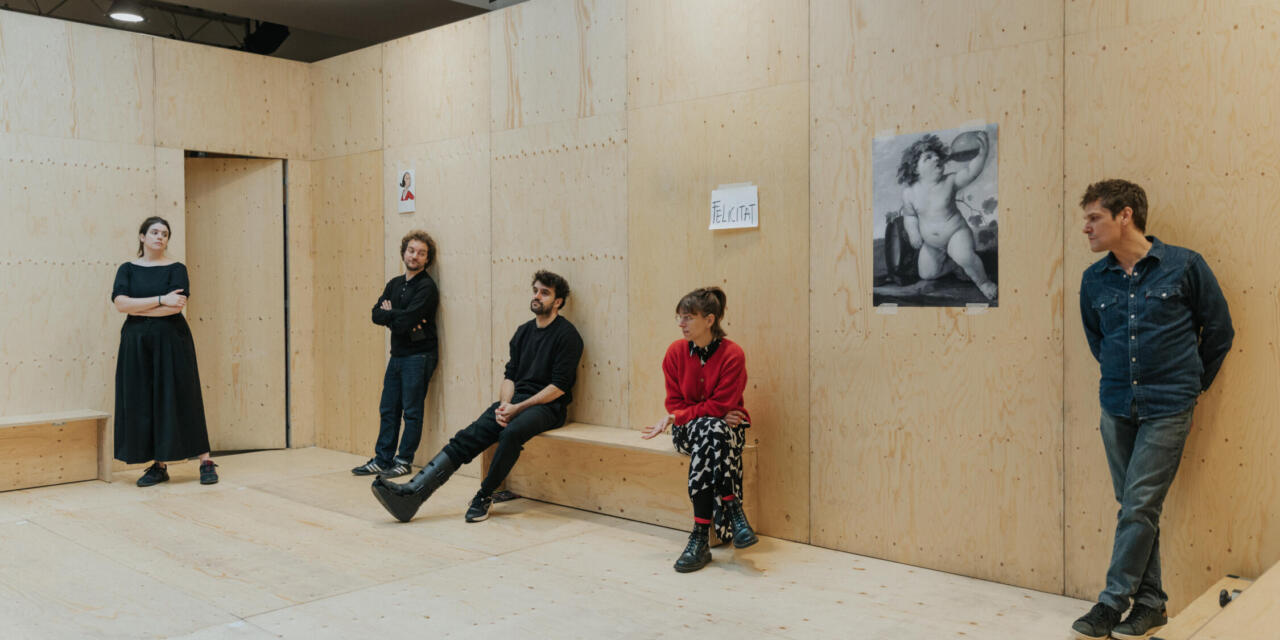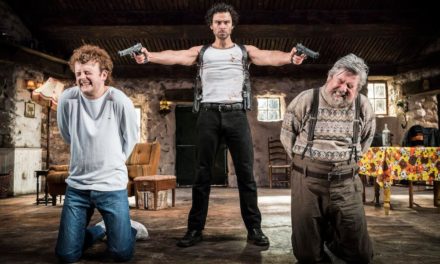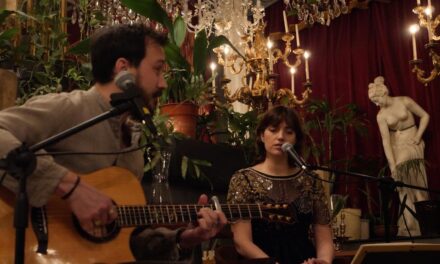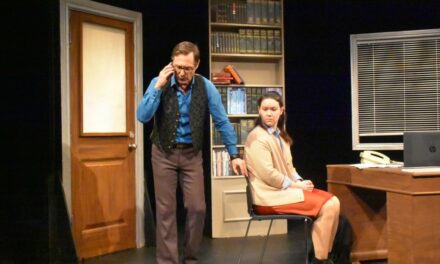Catalan director Àlex Rigola, the former artistic director of the Venice Biennale’s theatre section, likes boxes. Many of his scenographic configurations have gravitated around a structure which the audience look into — a fishbowl, as with Glengarry Glen Ross (2003) or a pine box where we are trapped with the performers in a space that appears neither theatre nor life but where the boundaries between the two are blurred, as in his reworking of Uncle Vanya entitled Vania (escenas de la vida) (2017). The wooden box has been his preferred space of late, an agora with steep steps and a narrow stage space and it will shape the new theatre he plans to open in Barcelona, a 72-seat venue at the Plaza Olivereta, en Badal – an area that doesn’t currently boast a theatre building. It is also very much on display in his reworking of Hedda Gabler which opened at Barcelona’s Lliure de Gràcia in late December 2022. Here with his company Heartbreak Hotel – a laboratory of sorts for exploring the whys and wherefore of theatre — he directs a minimalist jazz riff on the play. A group of actors provide a discussion on Ibsen’s Hedda Gabler but one where they keep their own names, taking on the characteristics of Ibsen’s characters as a way of debating the implications of their decisions. It is as if we are observing a rehearsal — and rehearsals are a way of showing the process of making work — but one that is polished, clean and neat. There is no mess on this stage, no clutter – everything is brutally exposed under the harsh lighting that bears down on the characters: an approach inspired by Anne Bogart’s Viewpoints.
A warning alerts the audience that the show is not recommended for people with claustrophobia. The wooden box that the audience enter, with raked seats where spectators looking down onto the actors, looks barely finished – all bare pine walls with a single drawing of Olive Oil, Popeye’s wife, pinned on the wall. The actors lead the audience into the box; they are dressed much like the audience – jeans, casual tops, trainers – and watch the audience (and each other) as they stand against the back wall of the stage, sit on the steps and just wait. There’s a lot of waiting in this production. Waiting for each other, waiting for the lines that inevitably come, waiting with an audience, waiting for time to pass. Waiting. In a world where everyone is in a hurry and not always understanding why, the invitation to watch and wait feels timely. An audience may know what will happen, if familiar with the plot of this iconic work. The transaction we have entered into involves a process of waiting for the inevitable action that will come to pass. For newcomers, the piece revolves around a group of friends and acquaintances navigating existential crises.
The bare eight by six metre box, designed by Max Glaenzel, is the Tesmans living room. Only characters don’t come and go; here there is no backstage, no world beyond, just the room in which audience and actors are placed by Rigola. We are all trapped together. The audience know there is a world beyond – the lighting grid of the Lliure de Gràcia theatre is all too visible above the roof of the box.
The production provides a series of reflections on happiness – the Catalan felicitat is written on a piece of paper and stuck onto the back wall. And the pursuit of happiness feels very present in the production, alongside further motifs of self-destruction, tedium, obsession and moral quandaries. The characters both debate these issues directly and display them in action – tedium is very visible, almost spilling into disdain at certain moments.
Debate is at the core of the production, conversation the order of the game. Snippets of the quintet’s lives appear through the dialogue – moments that give a context to this reflection on the play. The cartoon drawing of Olive is the only manifestation of aunt Juliana, who has paid for the Tesmans – here Joan Solé and Nausicaa Bonnín’s — travels. Joan Solé and Pol (López) are academics – a position at the university has come up and with unspoken competition as to who will get it – is it Joan’s or is Pol in contention? Pol’s masterpiece is unseen: notes in a moleskin notebook. Glances between Pol and Nausicaa point to a past history that dare not speak its name. Marc Rodríguez watches from the stairs – a Judge Brack of sorts with a snarl and a side look. He will be making decisions on who gets the job, or so the audience is led to believe. He avoids confrontation as if operating from the margins, a puppeteer who stands close, but not too close to Nausicaa.
The characters feel nailed to their existence, it is as if they too are stuck to the back wall they lean against, or the stairs that they sit on. Joan sits a lot, on a bench against the back wall of the stage, on the floor; it is a form of inertia. All the characters appear trapped by inertia and an emotional malaise that is never directly named. Hedda (Nausicaa Bonnín) herself watches and is watched. The most restless of the quintet; she fidgets, unable to adapt to the space. Her hair is tied up in a ponytail as if she fears letting it down. There is a sense of unease about her – the pacing, the looks to her fellow actors, especially Miranda Gas, the piece’s Thea. This is no evil Hedda, simply a figure eaten by her frustration and anger, a wish for a life that she perhaps cannot define but that she feels cannot be hers. Her destiny is pre-determined from the start and her demeanour carries this weight. She brings the gun onstage. She loads it, points it at Thea and Marc and passes it between her and Pol: hers will be an offstage death for after the performance closes. But it is a death we know is coming. A death foretold. Just as Lövborg’s death comes in Hedda Gabler, Pol commits suicide, even if he remains on stage to the end of the piece. He is an actor who is still present, a character who has killed himself – both actor and character coexist in Pol’s bodily presence.
This is seventy-five minutes of lean, crisp theatre. The characters have referents but these are not stable, rather something that an audience searches for as it tries to align actor to character and role. The production reminded me of Forced Entertainment – a dismantling of or questioning of the conventions of theatre as a way of asking an audience what theatre is and why they want to be part of it. Nausicaa caresses a painting of a chérubin drinking from a glass carafe that she sticks to the back wall. It is an image of corrupted innocence perhaps, or an image of the unattainable. Meaning is too elusive to be fixed in this production.
Rigola isn’t afraid to make things difficult or uncomfortable for an audience. Theatre has never been a sanitised space for Rigola but rather a place to ask difficult questions, a space for listening and a space for thinking, a place where as an audience member you may feel like both a witness and a voyeur. And there is silence which punctuates the production: silence not just at the end but across the whole performance. An awkward silence. A strange silence. A fearful silence. A silence of anticipation. And at the end the word felicitat remains stuck to the wall – a reminder that this may be what is aspired to but it isn’t always realised. Desire, as this production eloquently shows its audience, always exceeds the means through which it can be satisfied.
Hedda Gabler will tour to Madrid later in the year.
This post was written by the author in their personal capacity.The opinions expressed in this article are the author’s own and do not reflect the view of The Theatre Times, their staff or collaborators.
This post was written by Maria Delgado.
The views expressed here belong to the author and do not necessarily reflect our views and opinions.


















